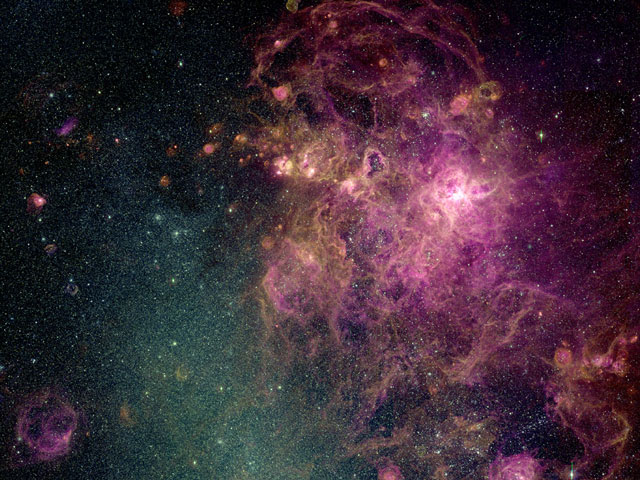Explanation: The Tarantula Nebula is more than 1,000 light-years across - a giant emission nebula within our neighboring galaxy the Large Magellanic Cloud. Inside this cosmic arachnid lies a central young cluster of massivestars, cataloged as R136, whose intense radiation and strong winds have helped energize the nebular glow and shape the spidery filaments. In this impressive color mosaic of images from the Curtis Schmidt telescope at Cerro Tololo Inter-American Observatory (CTIO) in Chile, other young star clusters can be seen still within the nebula's grasp. Also notable among the denizens of the Tarantula zone are several dark clouds, sprawling wispy filaments of gas, compact emission nebula, nearly spherical supernova remnants, and areas surrounding hot stars known as superbubbles. The rich mosaic's field of view covers an area on the sky about the size of the full moon in the southern constellation Dorado.
1999 2000 2001 2002 2003 2004 2005 2006 2007 2008 2009 2010 2011 2012 2013 2014 2015 2016 2017 2018 2019 2020 2021 2022 2023 2024 2025 |
Yanvar' Fevral' Mart Aprel' Mai Iyun' Iyul' Avgust Sentyabr' Oktyabr' Noyabr' Dekabr' |
NASA Web Site Statements, Warnings, and Disclaimers
NASA Official: Jay Norris. Specific rights apply.
A service of: LHEA at NASA / GSFC
& Michigan Tech. U.
|
Publikacii s klyuchevymi slovami:
30 Doradus - star cluster - Tarantula Nebula - Tumannost' Tarantul - zvezdnoe skoplenie
Publikacii so slovami: 30 Doradus - star cluster - Tarantula Nebula - Tumannost' Tarantul - zvezdnoe skoplenie | |
Sm. takzhe:
Vse publikacii na tu zhe temu >> | |
